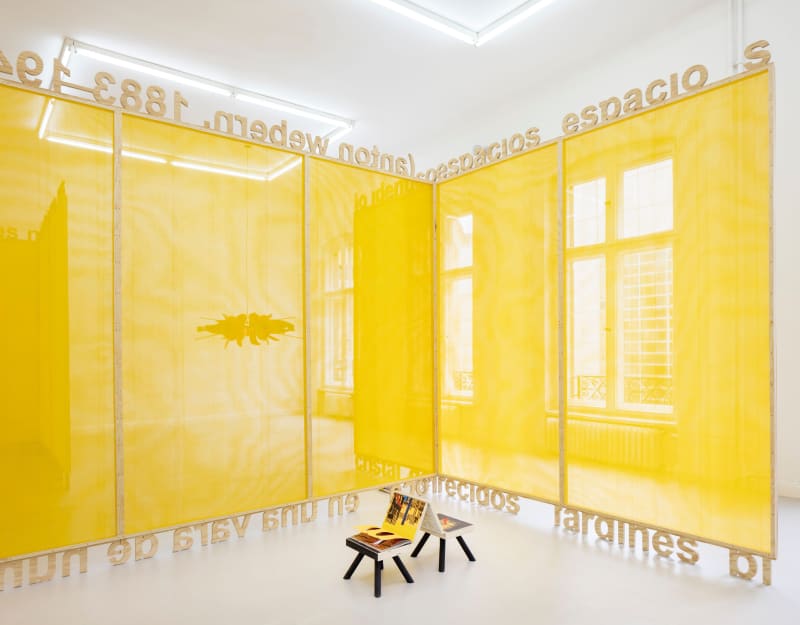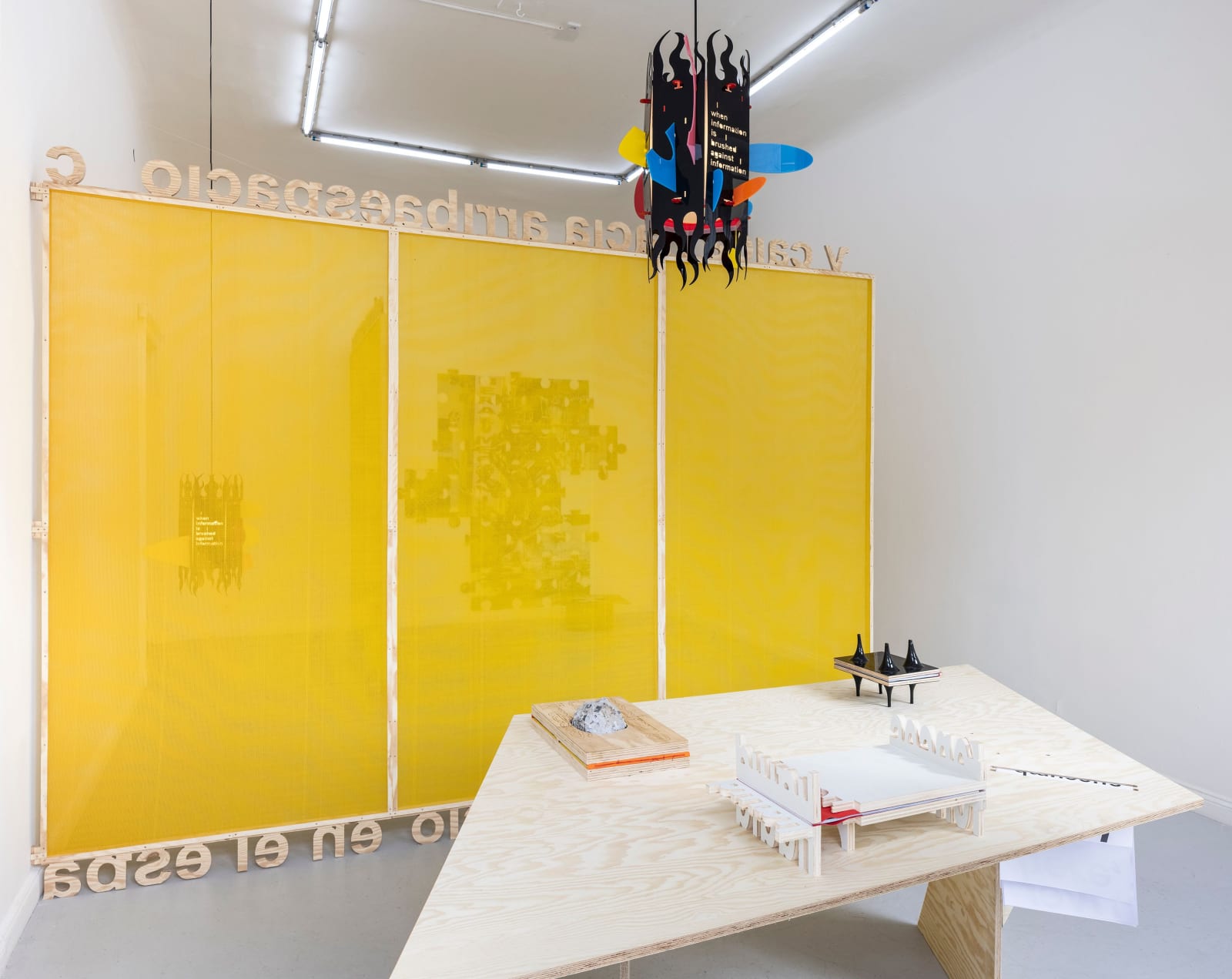Notations from Somewhere: Rafael Domenech
Hua International is pleased to announce “Notations from Somewhere,” Rafael Domenech’s first solo show in Berlin. In addition to the gallery exhibition, the Cuban-born, New York-based artist, has created two parallel projects around Potsdamer Straße that highlight Domenech’s distinctive approach to exhibition-making.
Rafael Domenech is at the forefront of a new generation of artists that is redefining the exhibition experience. Domenech’s conceptual practice ranges from small artist’s books to large-scale architectural constructions that often work in tandem with one another. In “Notations from Somewhere,”the exhibition takes the form of an experimental publication that constructs and deconstructs the complex book- architecture-city interrelations. For Domenech, exhibition-making is much like publishing: the editorial decisions aim to develop a sequence of moments that create a context for an aesthetic experience. The works in the exhibition integrate the convulsive dynamism of the city and thus heighten our awareness of architecture and the urban landscape outside of the gallery space.
The first work one encounters in the exhibition has stacked Marshall McLuhan’s The Medium is the Message on top of a rock and wedged it into the wall. With this architectural intervention Domenech points to the tension between poetry, discourse, artwork, and architectural structure that is at the heart of the spectator’s experience. Meanwhile, the yellow semi-translucent screens that run through the gallery act as room dividers inspired by Chinese folding screens, but they also transform the three main rooms of the gallery into one large labyrinth-like architectural publication. The text that runs across the top and the bottom of the screens contains the complete poem by the Mexican poet Octavio Paz titled, “Lo Idéntico”, or “the identical/same” in English. The screens, which are built out of repurposed “bad infinity” materials such as plywood and construction mesh, are modular and can be separated to become stand-alone art objects that act simultaneously as 4x8-feet paintings and word sculptures. The thickness of the wood cut word poem emphasizes the international standard size for construction. A sole grey mesh framed by plywood text leans against the wall as a final painting in the sequence.Paz is a major source of inspiration for the artist and also features in another work by Domenech.In“plastic sunshine-opaque transparencies” (2021) an orange electrical cable runs across the second and third floor of the gallery cutting through the floor/ceiling that leads to the offices.
This approach extends to other works on view, including “The Elliptical Hour,” a group of works that are carefully placed across the three rooms and have two configurations: open and closed. The visitors can ask the gallery’s assistant to open and position the books on the wall. When they hang vertically, the “The Elliptical Hour” works resemble posters or paintings that are constructed out of image-tiled laser-print paper overlaid with commercial vinyl. Arranging and rearranging works throughout the exhibition produces an oscillatory motion that invites for a promiscuous viewing experience much like that of cities. This unique approach asks the viewer to consider Domenech’s individual works as part of an artist’s book, where as he says, “objects are words in a poem, the building is the page.”At the same time, the gallery is not simply a container for displaying discreet art objects, instead, the book-architecture complex presents change as a permanent state of our fragmentary post-industrial life, an experience full of affirmation, negation, ambivalence and contradiction.
Parallel projects
The exhibition spirals out of the gallery space into various city-wide projects inspired by a work of literature that provides a unique perspective on Berlin, Every Man Dies Alone (1947) by Hans Fallada. The novel is based on a true story of a working-class couple that left letters of resistance against the Nazis across occupied Berlin after the death of their son during World War II. Every day they dropped postcards that said, “Mother! The Führer has murdered my son. Mother! The Führer will murder your sons too” in mailboxes, on benches, or just drop them on the ground. These silent billboards of dissent pointed in a wealth of directions all at once: civil disobedience, concrete poetry, architecture, proximity, and dislocation. All the parallel projects relate back to the exhibition through our own traveling and the repeated experience of the message-poems that underscore the relationship between here, nowhere, everywhere, and somewhere in Domenech’s practice. These bridging realities and interconnecting spaces always point to how much remains unknown.
In There is no longer an elsewhere (2021) Rafael Domenech has taken a cue from Fallada’s novel and created a permanent installation on the ceiling of P71, a traditional Berlin late-night shop (colloquially known as späti) located at Potsdamerstraße 71. The phrase “Here, we burnt the river” was discovered while researching the archives of the keystone historic 1892 “Homestead Strike” in Pittsburg, a defeat that marked a turning point for American labor Unions. The phrase is re-appropriated by the artist as a visual poem in various works for its potent image. The phrase is transformed into a calligram cut onto the späti’s square ceiling tiles (each tile becomes a single letter), while it also serves as a silent memorial to a pivotal battle in labor history. On one side, the steelworkers who wanted to form a union in Pittsburgh, on the other side, Andrew Carnegie the owner of the factory, and Henry Clay Frick the manager hired to fight the unions. The violent confrontation which left many dead was fought on the riverfront—a bloody image that juxtaposes both these famous industrialists’ prestigious luxury estates filled with masterpieces of art. During the strike, the steelworkers burned down what they could in protest but it only led to frustration, in desperation, they spilled oil on the Pittsburgh river and tried to light it on fire. The poem expresses the rage against the social injustices and the desire of protesters to rise up together.
parallel project 1
There is no longer an elsewhere
Concrete poem on ceiling tiles
Location: P71 Spätkauf on Potsdamerstraße 71
parallel project 2
Hopscotch Reading Room
Artist intervention in New York Review of Books Location: Kurfürstenstraße 14/Haus B











